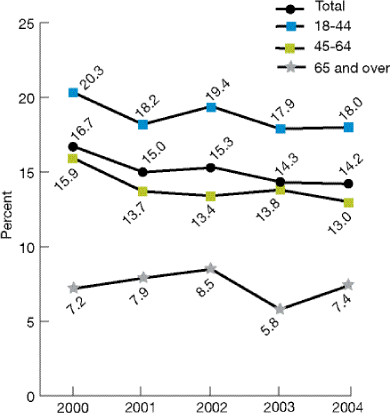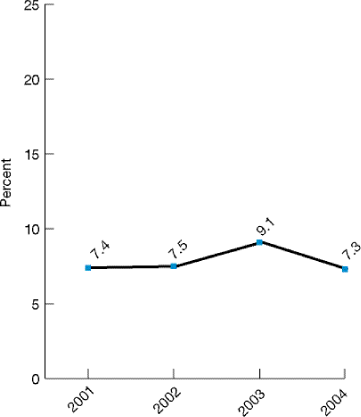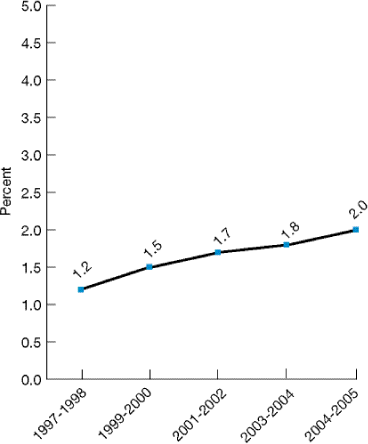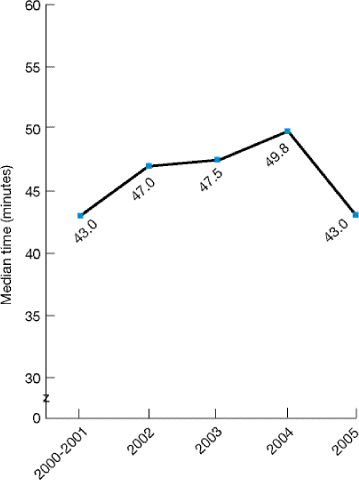Chapter 4. Timeliness
Timeliness is the health care system's capacity to provide health care quickly after a need is recognized. Timeliness is one of the six dimensions of quality established by the Institute of Medicine as a priority for improvement in the health care system.1 Measures of timeliness include waiting time spent in doctors' offices and emergency departments (EDs) and the interval between identifying a need for specific tests and treatments and actually receiving those services.
Importance and Measures
Morbidity and Mortality
- Lack of timeliness can result in emotional distress, physical harm, and higher treatment costs for patients.2, 3
- Stroke patients' mortality and long-term disability are largely influenced by the timeliness of therapy.4, 5
- Timely delivery of appropriate care can also help reduce mortality and morbidity for chronic conditions such as chronic kidney disease.6
- Timeliness in childhood immunizations helps maximize the protection from vaccine- preventable diseases, while minimizing risks to the child and reducing the chance of disease outbreaks.7
- Timely antibiotic treatments are associated with improved clinical outcomes.8
Cost
- Early care for comorbid conditions has been shown to reduce hospitalization rates and costs for Medicare beneficiaries.9
- Some research suggests that, over the course of 30 years, the costs of treating diabetic complications can approach $50,000 per patient.10 Early care for complications in patients with diabetes can reduce overall costs of the disease.11
- Timely outpatient care can reduce admissions for pediatric asthma, which in 2003 accounted for more than $1.25 billion in total hospitalization charges.12, 13
Measures
This report focuses on three core report measures related to timeliness of primary, emergency, and hospital care:
- Getting care for illness or injury as soon as wanted.
- Emergency department visits in which the patient left without being seen.
- Time to initiation of thrombolytic therapy for heart attack patients.
Return to Contents
Findings
Getting Care for Illness or Injury As Soon As Wanted
A patient's primary care provider should be the point of first contact for most illnesses and injuries. The ability of patients to receive treatment for illness and injury in a timely fashion is a key element in a patient-focused health care system.
Figure 4.1. Adults who reported sometimes or never getting care for illness or injury as soon as wanted in the last 12 months, by age group, 2000-2004

Source: Agency for Healthcare Research and Quality, Medical Expenditure Panel Survey, 2000-2004.
Reference population: Civilian noninstitutionalized population age 18 and over.
Figure 4.2. Children whose parents reported that they sometimes or never got care for illness or injury as soon as wanted in the last 12 months, 2001-2004

Source: Agency for Healthcare Research and Quality, Medical Expenditure Panel Survey, 2001-2004.
Reference population: Civilian noninstitutionalized population under age 18.
- From 2000 to 2004, the percentage of adults who reported that they sometimes or never got care for illness or injury as soon as wanted in the last 12 months improved overall, decreasing from 16.7% to 14.2% (Figure 4.1). Adults ages 45-64 were the only age subgroup for which a modest improvement was observed in this measure between 2000 and 2004 (15.9% to 13.0%).
- In all five data years, the proportion of adults who reported that they sometimes or never got care for illness or injury as soon as wanted was lower among those ages 45-64 and age 65 and older than those ages 18-44.
- Among children who had appointments reported for illness or injury during the last 12 months, 7.3% sometimes or never got care as soon as wanted in 2004 (Figure 4.2). This rate did not improve between 2001 and 2004.
- From 2001 to 2004, there was no significant difference on this measure between children under age 6 and children ages 6-17 (data not shown).
Emergency Department Visits in Which the Patient Left Without Being Seen
In 2004, patients visiting emergency departments (EDs) in the United States spent an average of 47.4 minutes waiting to be seen by a physician. This may be a result of the 18% increase in ED visit volumes over a 10-year period as the number of ED facilities decreased by 12.4%.14 Although many factors may lead a patient seeking care in a hospital ED to leave without being seen, long waits tend to exacerbate this problem.
Figure 4.3. Emergency department (ED) visits in which the patient left without being seen, 1997-1998, 1999-2000, 2001-2002, 2003-2004, and 2004-2005

Source: Centers for Disease Control and Prevention, National Center for Health Statistics, National Hospital Ambulatory Medical Care Survey, 1997-1998, 1999-2000, 2001-2002, 2003-2004, and 2004-2005.
Denominator: Visits to EDs of general and short-stay hospitals.
- From 1997-1998 to 2004-2005, the overall percentage of ED visits in which the patient left before being seen increased from 1.2% to 2.0% (Figure 4.3).
Time to Initiation of Thrombolytic Therapy for Heart Attack Patients
The capacity to treat hospital patients in a timely fashion is especially important for emergency situations such as heart attacks. For patients suffering from a heart attack, early interventions—such as percutaneous coronary stenting and thrombolytic therapy— may reduce heart muscle damage and save lives.15
Figure 4.4. Median time (minutes) from arrival of heart attack patients to initiation of thrombolytic therapy, 2000-2005

Source: Centers for Medicare & Medicaid Services, Quality Improvement Organization Program, 2000-2005.
Denominator: Adult patients meeting all of the following criteria: (1) principal diagnosis of acute myocardial infarction; (2) ST segment elevation or left bundle branch block on the electrocardiogram performed closest to hospital arrival time; and (3) thrombolytic therapy during the hospital stay.
Notes: Beginning in 2005, the data collection method changed from the abstraction of randomly selected medical records for Medicare beneficiaries to the receipt of hospital self-reported data for all payer types.
- Among heart attack patients, the median time from hospital arrival to the initiation of thrombolytic therapy was 43 minutes in 2005. Although this represents an improvement compared to 2004, when the rate peaked at 49.8 minutes, it is unchanged from performance in 2000-2001 (Figure 4.4).
- The median time to the initiation of therapy with thrombolytic agents remains well above the national target of 30 minutes set by the American College of Cardiology and the American Heart Association.16
Return to Contents
References
1. Institute of Medicine, Committee on Quality of Health Care in America. Crossing the quality chasm: a new health system for the 21st century. Washington, DC: National Academy Press; 2001. p. 53-54.
2. Leddy KM, Kaldenberg DO, Becker BW. Timeliness in ambulatory care treatment. An examination of patient satisfaction and wait times in medical practices and outpatient test and treatment facilities. J Ambul Care Manage. 2003 Apr-Jun; 26(2): 138-49.
3. Boudreau RM, McNally C, Rensing EM, et al. Improving the timeliness of written patient notification of mammography results by mammography centers. Breast J. 2004 Jan-Feb; 10(1): 10-19.
4. Schellinger PD, Warach S. Therapeutic time window of thrombolytic therapy following stroke. Curr Atheroscler Rep. 2004 Jul; 6(4): 288-94.
5. Kwan J, Hand P, Sandercock P. Improving the efficiency of delivery of thrombolysis for acute stroke: a systematic review. QJM. 2004 May; 97(5): 273-79.
6. Kinchen KS, Sadler J, Fink N, et al. The timing of specialist evaluation in chronic kidney disease and mortality. Ann Intern Med. 2002 Sep 17;137(6):479-86.
7. Luman ET, Barker LE, Shaw KM, et al. Timeliness of childhood vaccinations in the United States: days under-vaccinated and number of vaccines delayed. JAMA. 2005 Mar 9;293(10):1204-11.
8. Houck PM, Bratzler DW. Administration of first hospital antibiotics for community-acquired pneumonia: does timeliness affect outcomes? Curr Opin Infect Dis. 2005 Apr; 18(2): 151-56.
9. Himelhoch S, Weller WE, Wu AW, et al. Chronic medical illness, depression, and use of acute medical services among Medicare beneficiaries. Med Care. 2004 Jun;42(6):512-21.
10. Caro JJ, Ward AJ, O'Brien JA. Lifetime costs of complications resulting from type 2 diabetes in the U.S. Diabetes Care. 2002 Mar; 25(3): 476-81.
11. Ramsey SD, Newton K, Blough D, et al. Patient-level estimates of the cost of complications in diabetes in a managed-care population. Pharmacoeconomics. 1999 Sep;16(3):285-95.
12. Mellon M, Parasuraman B. Pediatric asthma: improving management to reduce cost of care. J Manag Care Pharm. 2004 Mar-Apr; 10(2): 130-41.
13. Calculated from: Agency for Healthcare Research and Quality. Healthcare Cost and Utilization Project. 2003 Kids' Inpatient Database. Available at: http://hcup.ahrq.gov/HCUPnet.asp. Accessed October 30, 2007.
14. McCaig LF, Nawar EW. National Hospital Ambulatory Medical Care Survey: 2004 emergency department summary. Adv Data. 2006 Jun 23;(372):1-32.
15. Kloner RA, Rezkalla SH. Cardiac protection during acute myocardial infarction: where do we stand in 2004? J Am Coll Cardiol. 2004 Jul 21;44(2):276-86.
16. Antman EM, Anbe DT, Armstrong PW, et al. ACC/AHA guidelines for the management of patients with ST-elevation myocardial infarction—executive summary: a report of the American College of Cardiology/American Heart Association Task Force on Practice Guidelines (Writing Committee to Revise the 1999 Guidelines for the Management of Patients With Acute Myocardial Infarction). Circulation. 2004 Aug; 110(5): 588-636.

